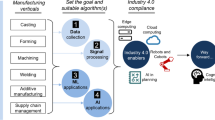Abstract
The present situation in production engineering is characterized by a need to create organizational structures and production methods which enable a reduction of the product development time and continuously improved product quality. Together with an improvement in productivity, cost savings and quality assurance, the success of a company will increasingly depend on shortened throughput times, flexibility and the full utilization of its employees' creativity. Laser technology offers important contributions to these aims, if its related technical and organizational advantages can be fully exploited.
On an organizational level, the simultaneous development of product, process and production system and multilevel quality control loops enables preventive quality assurance and continuous improvement of product quality. Simulation tools for process, process flow and laser systems allow reliable planning data at a very early stage in product design and operations planning.
On the manufacturing level, e.g. in the field of prototype building, the laser is used as a flexible tool for cutting two- and three-dimensional body panels. Owing to the need for programming, the downtimes for 3D laser cutting systems can be quite considerable. Computer-aided, comprehensive process chains enabling off-line programming are therefore increasingly being adopted. The use of the laser in prototype shops makes it possible to provide production-equivalent components at a high level of reproducibility and with much shorter lead times.
System status monitoring tools enable full operator control and fast fault rectification. Seam tracking sensors with moving laser beam and moving workpiece allow compensation of tolerances in part shape and position. By measuring the gap distance during seam tracking, suitable adaptation of process parameters makes it possible to achieve a controlled welding process. As a continuation of preventive quality assurance measures, process monitoring using characteristics of the laser-induced plasma during welding reveals defects in the weld seam.
Similar content being viewed by others
References
G. Reinhart et al., Wettbewerbsfähige Produktion — Voraussetzung für eine strategische Entscheidung, Tagungsband zum Münchener Kolloquium '94 (Mi-Verlag, Landsberg, 1994).
H. Hornig and G. Reinhart, laser 4 (1990) 240.
F. Breun and G. Reinhart, Automobilproduktion 1 (1991) 16.
H. Lindl and W. Trunzer, Proc. Int. Conf. Optics for Productivity in Manufacturing, Frankfurt, 1994, SPIE 2246.
M. Beck, P. Berger and H. Hügel, ECLAT 92 (DGM-Informationsgesellschaft Verlag, Oberursel, 1992).
F. Garnich, Laserbearbeitung mit Robotern, IWB Forschungsberichte 50 (Springer Verlag, Berlin, 1992).
J. Milberg et al., Wettbewerbsfaktor Zeit in Produktionsunternehmen, Tagungsband Müchener Kolloquium '91 (Springer Verlag, Berlin, 1991).
J. Milberg et al., Proc. Int. Conf. LANE'94, (Meisenbach Verlag, Bamberg, 1994) p. 669.
H. Schwarz, Simulationsgestützte CAD/CAM-Kopplung für die 3D-Laserbearbeitung mit integrierter Sensorik, IWB Forschungsberichte 68 (Springer Verlag, Berlin, 1993).
J. Milberg, W. Trunzer and H. Lindl, WGP Annals 1 (1993) 2.
W. Trunzer, H. Lindl and H. Schwarz, Proc. Int. Conf. Laser Applications in the Automotive Industries, 26th ISATA, Aachen, 1993, p. 195.
Author information
Authors and Affiliations
Rights and permissions
About this article
Cite this article
Reinhart, G., Milberg, J., Lindl, H. et al. Laser systems in modern production environments. Opt Quant Electron 27, 1103–1125 (1995). https://doi.org/10.1007/BF00326470
Received:
Issue Date:
DOI: https://doi.org/10.1007/BF00326470




